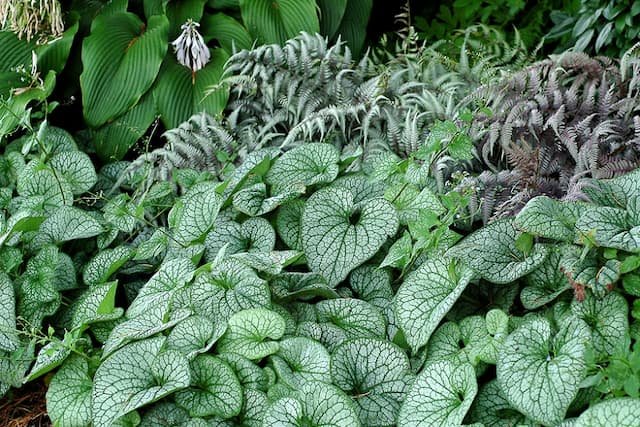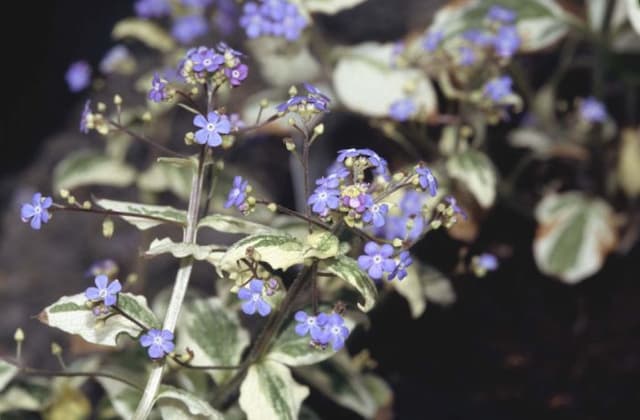Lungwort Pulmonaria angustifolia 'Azurea'

ABOUT
The plant commonly known as Azure Lungwort is a herbaceous perennial that is notable for its striking foliage and delicate flowers. The leaves of the Azure Lungwort are somewhat oval in shape, with a rough texture and a distinctive spotted pattern that can vary from white to silver. The pattern gives the appearance of being speckled, which adds a unique visual interest even when the plant isn't in bloom. The Azure Lungwort blooms in early spring, producing clusters of small, funnel-shaped flowers. These flowers are known for their vivid blue color, which stands out beautifully against the mottled foliage. The contrast of the blue petals against the green leaves with pale spots creates a charming display that is highly appreciated in shade gardens or woodland settings. The foliage often changes through the seasons with the leaves taking on a different appearance or texture, which can add to the year-round interest of the plant in a garden. This Lungwort is valued for its low-maintenance nature and its ability to thrive in shady conditions where many other plants might struggle. It is often planted as ground cover or in borders, lending a touch of color and pattern to shaded garden areas.
About this plant
 Names
NamesFamily
Boraginaceae
Synonyms
Blue Lungwort, Narrow-leaved Lungwort
Common names
Pulmonaria azurea, Pulmonaria caerulea.
 Characteristics
CharacteristicsLife cycle
Perennials
Foliage type
Evergreen
Color of leaves
Green
Flower color
Blue
Height
1 foot (30 cm)
Spread
1 foot (30 cm)
Plant type
Herb
Hardiness zones
4
Native area
Europe
Benefits
 General Benefits
General Benefits- Attracts Pollinators: Pulmonaria angustifolia 'Azurea', commonly known as Lungwort, is highly attractive to bees and other beneficial insects, which is good for the garden ecosystem.
- Shade Tolerant: Lungwort is well-suited for shaded areas of the garden, providing interest where other plants might struggle to grow.
- Low Maintenance: Lungwort is a hardy perennial that requires minimal upkeep once established, making it ideal for gardeners looking for easy-care plants.
- Spring Blooming: Lungwort offers early spring flowers, which can add color to the garden when most other plants have not yet bloomed.
- Ground Cover: With its spreading habit, Lungwort makes an effective ground cover, filling in space and suppressing weed growth.
- Ornamental Foliage: Lungwort has unique spotted or mottled leaves that provide visual interest even when the plant is not in flower.
- Deer and Rabbit Resistant: The foliage of Lungwort is not palatable to deer and rabbits, making it a good choice for areas with wildlife pressures.
 Medical Properties
Medical Properties- Respiratory support: The common name "Lungwort" suggests its historical use in treating respiratory conditions.
- Anti-inflammatory activity: Traditionally, Lungwort has been used for its anti-inflammatory properties.
- Astringent effects: Lungwort may possess astringent properties, which can help in wound healing and skin conditions.
 Air-purifying Qualities
Air-purifying QualitiesThis plant is not specifically known for air purifying qualities.
 Other Uses
Other Uses- Lungwort 'Azurea' can be used as a natural dye. The leaves yield a variety of green hues suitable for dying fabrics or yarn.
- The plant adds texture and interest to wildlife gardens. Insects, such as bees, are attracted to its nectar-rich flowers, supporting biodiversity.
- Lungwort 'Azurea' leaves can be included in a compost heap to add nutrient variety and aid in the decomposition process due to their rich mineral content.
- This plant can be used as an indicator for soil pH, as it prefers alkaline soils. Its presence can signify soil conditions without the need for a soil test.
- It can serve educational purposes in botany or gardening classes, demonstrating plant adaptations like its hairy leaves, which help reduce water loss.
- Lungwort 'Azurea' can act as a ground cover to prevent soil erosion on slopes or banks, with its spreading habit and robust root system.
- The distinctive spotted leaves can be used to create artistic leaf rubbings for craft projects or nature-inspired art.
- In larger ponds or water garden settings, Lungwort 'Azurea' can be planted in damp soil areas to enhance the aesthetic of water-based landscapes.
- Acting as an early bloomer, Lungwort 'Azurea' can provide important foraging opportunities for pollinators when other floral resources are scarce in early spring.
- The plant's foliage can be used to add an interesting structural element in floral arrangements, especially during the periods it's not in bloom.
Interesting Facts
 Feng Shui
Feng ShuiThe Lungwort is not used in Feng Shui practice.
 Zodiac Sign Compitability
Zodiac Sign CompitabilityThe Lungwort is not used in astrology practice.
 Plant Symbolism
Plant Symbolism- Healing: Pulmonaria angustifolia 'Azurea', commonly known as Lungwort, is traditionally associated with respiratory health and healing due to its lung-like spotted leaves, reflecting the Doctrine of Signatures where plants were believed to treat the organs they resemble.
- Protection: In folk medicine, Lungwort was often used to ward off evil spirits and diseases, symbolizing protection and safety.
- Transition: The flowers of Lungwort change color as they age, usually from pink to blue, symbolizing change, transition, and the passage of time.
- Perseverance: As a hardy plant that emerges early in the spring, often while snow is still on the ground, Lungwort represents perseverance and the ability to thrive in challenging conditions.
- Balanced life: The dual-colored flowers also suggest a balance between two states, representing a balanced life and the harmony between youth and age.
 Water
WaterFor the Lungwort (Pulmonaria angustifolia 'Azurea'), it is crucial to maintain moist soil, particularly during its growing season in spring and fall. Water the plant deeply once a week, making sure to soak the soil to the root level. During hot or dry spells, increase watering to twice a week, providing about one gallon of water per session to ensure adequate moisture. Reduce watering in the winter when the plant is dormant, but do not allow the soil to become completely dry. Remember to adjust the frequency based on rainfall and temperature changes to avoid overwatering.
 Light
LightThe ideal light conditions for Lungwort include partial shade or dappled sunlight. This ensures the foliage does not get scorched by intense midday sun while still receiving adequate light. The best spot is under the canopy of open-branched trees or east-facing gardens where the plant can enjoy morning sunlight and afternoon shade.
 Temperature
TemperatureLungwort thrives in a temperature range between 60°F and 75°F, which are ideal conditions for its growth. It can survive temporary dips down to 50°F, but prolonged exposure to temperatures below this can harm the plant. Similarly, it should be protected from extreme heat above 80°F whenever possible to prevent stress.
 Pruning
PruningPrune Lungwort after flowering to maintain a neat shape and encourage a second bloom. Cut back the flower stems and any damaged or unsightly foliage. Annual pruning is generally sufficient, which should be done in late spring or early summer. It's also a good time to remove any dead leaves to improve air circulation.
 Cleaning
CleaningAs needed
 Soil
SoilLungwort thrives in moist, well-draining soil rich in organic matter. A mix of two parts garden soil, one part peat moss or well-rotted compost, and one part perlite would be ideal. The preferred soil pH for Lungwort is slightly acidic to neutral, roughly between 6.0 and 7.0.
 Repotting
RepottingLungwort typically doesn't need to be repotted often, as it's quite content in the same pot for a few years. It's best to repot the plant every 2-3 years or when it has outgrown its current container, to refresh the soil and provide more room for growth.
 Humidity & Misting
Humidity & MistingLungwort prefers a higher humidity environment but is quite adaptable and can thrive in average household humidity levels. Although it prefers humidity around 50%, it's important to ensure good air circulation to prevent any fungal diseases.
 Suitable locations
Suitable locationsIndoor
Place Lungwort in a shaded spot with no direct sun and ensure moist soil.
Outdoor
Lungwort prefers partial shade, moist soil, and cool conditions.
Hardiness zone
3-8 USDA
 Life cycle
Life cyclePulmonaria angustifolia 'Azurea', commonly known as Blue Lungwort, begins its life cycle as a seed, which after germinating in early spring, develops into a young seedling with small basal leaves. As the plant matures, it forms a clump of narrow, dark green leaves that are speckled with silver spots. In late spring to early summer, Blue Lungwort produces clusters of blue, trumpet-shaped flowers that attract pollinators such as bees, which facilitate its sexual reproduction resulting in seed formation. After flowering, the plant goes into a period of dormancy during the hot summer months, conserving energy. As temperatures cool in autumn, Blue Lungwort experiences a growth resurgence, but as winter approaches, the plant enters a winter dormancy phase, where above-ground foliage dies back, while the root system remains viable underground. In the subsequent spring, the cycle repeats itself with the plant emerging once again from dormancy to grow, flower, and eventually set seed.
 Propogation
PropogationPropogation time
Spring to Summer
Pulmonaria angustifolia 'Azurea', commonly known as Blue Lungwort, is typically propagated by division, which is the most popular method. The best time to divide Blue Lungwort is in the spring as the plant emerges from dormancy or in the late summer after the flowering has finished. To propagate by division, carefully dig up the plant, trying not to damage the root system. Once the plant is out of the ground, use your hands or a sharp knife to gently separate the clumps into smaller sections, ensuring each new section has a good portion of roots and shoots. Replant the divisions promptly, maintaining the same soil depth as the original plant, and water well to establish the new plants. The divisions should be spaced about 12 inches (approximately 30 centimeters) apart to give them room to grow. This method of propagation is straightforward and helps maintain the health and vigor of the plant by rejuvenating older clumps.









